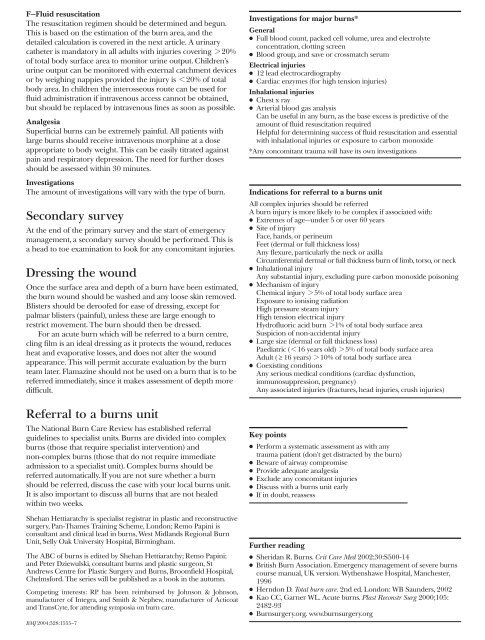ABC of Burns
Create successful ePaper yourself
Turn your PDF publications into a flip-book with our unique Google optimized e-Paper software.
F—Fluid resuscitation<br />
The resuscitation regimen should be determined and begun.<br />
This is based on the estimation <strong>of</strong> the burn area, and the<br />
detailed calculation is covered in the next article. A urinary<br />
catheter is mandatory in all adults with injuries covering > 20%<br />
<strong>of</strong> total body surface area to monitor urine output. Children’s<br />
urine output can be monitored with external catchment devices<br />
or by weighing nappies provided the injury is < 20% <strong>of</strong> total<br />
body area. In children the interosseous route can be used for<br />
fluid administration if intravenous access cannot be obtained,<br />
but should be replaced by intravenous lines as soon as possible.<br />
Analgesia<br />
Superficial burns can be extremely painful. All patients with<br />
large burns should receive intravenous morphine at a dose<br />
appropriate to body weight. This can be easily titrated against<br />
pain and respiratory depression. The need for further doses<br />
should be assessed within 30 minutes.<br />
Investigations<br />
The amount <strong>of</strong> investigations will vary with the type <strong>of</strong> burn.<br />
Secondary survey<br />
At the end <strong>of</strong> the primary survey and the start <strong>of</strong> emergency<br />
management, a secondary survey should be performed. This is<br />
a head to toe examination to look for any concomitant injuries.<br />
Dressing the wound<br />
Once the surface area and depth <strong>of</strong> a burn have been estimated,<br />
the burn wound should be washed and any loose skin removed.<br />
Blisters should be dero<strong>of</strong>ed for ease <strong>of</strong> dressing, except for<br />
palmar blisters (painful), unless these are large enough to<br />
restrict movement. The burn should then be dressed.<br />
For an acute burn which will be referred to a burn centre,<br />
cling film is an ideal dressing as it protects the wound, reduces<br />
heat and evaporative losses, and does not alter the wound<br />
appearance. This will permit accurate evaluation by the burn<br />
team later. Flamazine should not be used on a burn that is to be<br />
referred immediately, since it makes assessment <strong>of</strong> depth more<br />
difficult.<br />
Referral to a burns unit<br />
The National Burn Care Review has established referral<br />
guidelines to specialist units. <strong>Burns</strong> are divided into complex<br />
burns (those that require specialist intervention) and<br />
non{complex burns (those that do not require immediate<br />
admission to a specialist unit). Complex burns should be<br />
referred automatically. If you are not sure whether a burn<br />
should be referred, discuss the case with your local burns unit.<br />
It is also important to discuss all burns that are not healed<br />
within two weeks.<br />
Shehan Hettiaratchy is specialist registrar in plastic and reconstructive<br />
surgery, Pan-Thames Training Scheme, London; Remo Papini is<br />
consultant and clinical lead in burns, West Midlands Regional Burn<br />
Unit, Selly Oak University Hospital, Birmingham.<br />
The <strong>ABC</strong> <strong>of</strong> burns is edited by Shehan Hettiaratchy; Remo Papini;<br />
and Peter Dziewulski, consultant burns and plastic surgeon, St<br />
Andrews Centre for Plastic Surgery and <strong>Burns</strong>, Broomfield Hospital,<br />
Chelmsford. The series will be published as a book in the autumn.<br />
Competing interests: RP has been reimbursed by Johnson & Johnson,<br />
manufacturer <strong>of</strong> Integra, and Smith & Nephew, manufacturer <strong>of</strong> Acticoat<br />
and TransCyte, for attending symposia on burn care.<br />
BMJ 2004;328:1555–7<br />
Investigations for major burns*<br />
General<br />
x Full blood count, packed cell volume, urea and electrolyte<br />
concentration, clotting screen<br />
x Blood group, and save or crossmatch serum<br />
Electrical injuries<br />
x 12 lead electrocardiography<br />
x Cardiac enzymes (for high tension injuries)<br />
Inhalational injuries<br />
x Chest x ray<br />
x Arterial blood gas analysis<br />
Can be useful in any burn, as the base excess is predictive <strong>of</strong> the<br />
amount <strong>of</strong> fluid resuscitation required<br />
Helpful for determining success <strong>of</strong> fluid resuscitation and essential<br />
with inhalational injuries or exposure to carbon monoxide<br />
*Any concomitant trauma will have its own investigations<br />
Indications for referral to a burns unit<br />
All complex injuries should be referred<br />
A burn injury is more likely to be complex if associated with:<br />
x Extremes <strong>of</strong> age—under 5 or over 60 years<br />
x Site <strong>of</strong> injury<br />
Face, hands, or perineum<br />
Feet (dermal or full thickness loss)<br />
Any flexure, particularly the neck or axilla<br />
Circumferential dermal or full thickness burn <strong>of</strong> limb, torso, or neck<br />
x Inhalational injury<br />
Any substantial injury, excluding pure carbon monoxide poisoning<br />
x Mechanism <strong>of</strong> injury<br />
Chemical injury > 5% <strong>of</strong> total body surface area<br />
Exposure to ionising radiation<br />
High pressure steam injury<br />
High tension electrical injury<br />
Hydr<strong>of</strong>luoric acid burn >1% <strong>of</strong> total body surface area<br />
Suspicion <strong>of</strong> non-accidental injury<br />
x Large size (dermal or full thickness loss)<br />
Paediatric ( < 16 years old) > 5% <strong>of</strong> total body surface area<br />
Adult ( ≥ 16 years) > 10% <strong>of</strong> total body surface area<br />
x Coexisting conditions<br />
Any serious medical conditions (cardiac dysfunction,<br />
immunosuppression, pregnancy)<br />
Any associated injuries (fractures, head injuries, crush injuries)<br />
Key points<br />
x Perform a systematic assessment as with any<br />
trauma patient (don’t get distracted by the burn)<br />
x Beware <strong>of</strong> airway compromise<br />
x Provide adequate analgesia<br />
x Exclude any concomitant injuries<br />
x Discuss with a burns unit early<br />
x If in doubt, reassess<br />
Further reading<br />
x Sheridan R. <strong>Burns</strong>. Crit Care Med 2002;30:S500-14<br />
x British Burn Association. Emergency management <strong>of</strong> severe burns<br />
course manual, UK version. Wythenshawe Hospital, Manchester,<br />
1996<br />
x Herndon D. Total burn care. 2nd ed. London: WB Saunders, 2002<br />
x Kao CC, Garner WL. Acute burns. Plast Reconstr Surg 2000;105:<br />
2482-93<br />
x <strong>Burns</strong>urgery.org. www.burnsurgery.org



